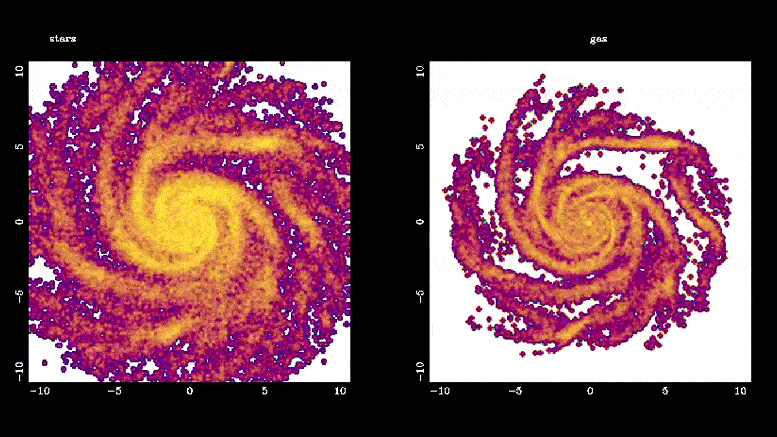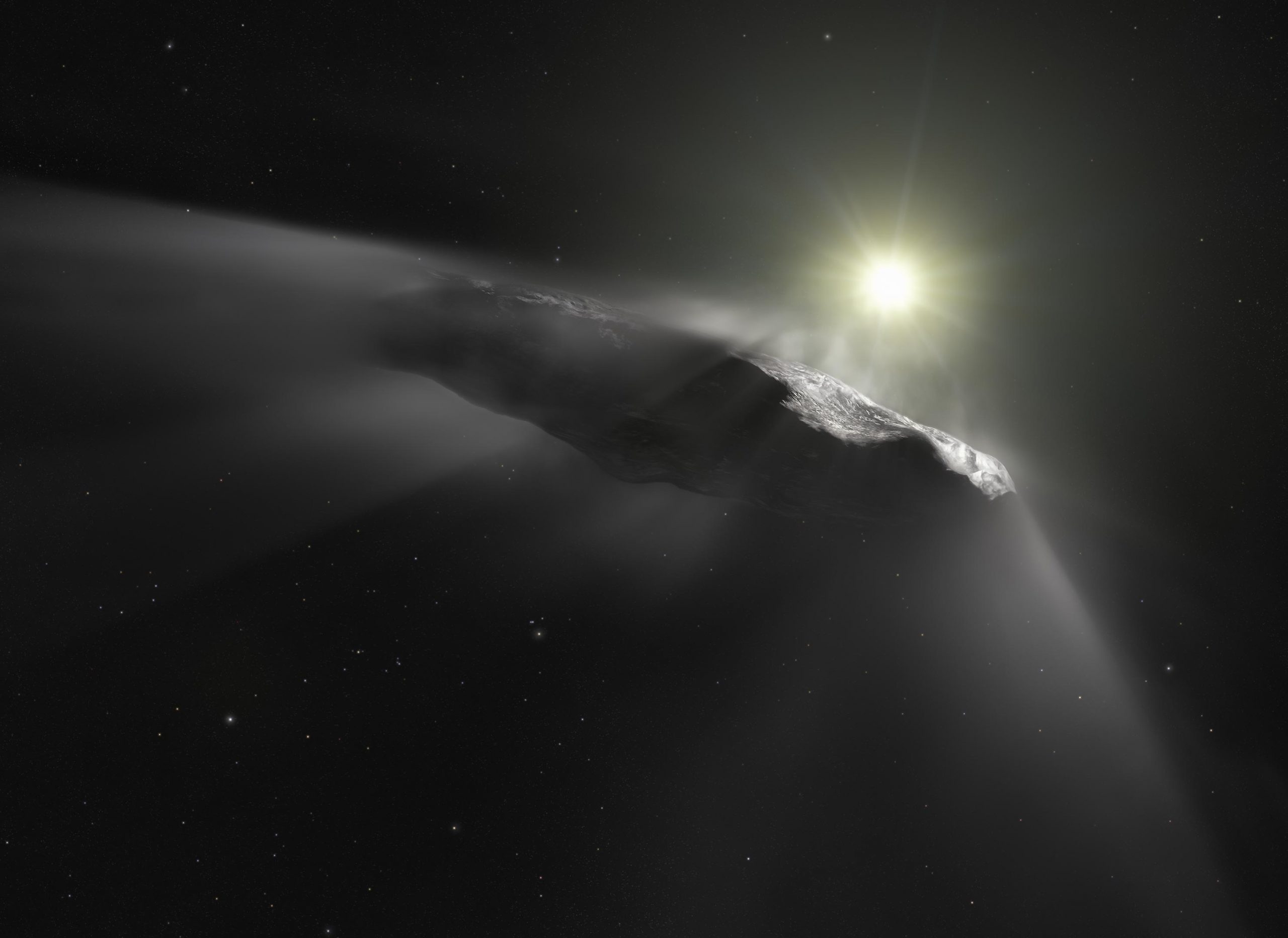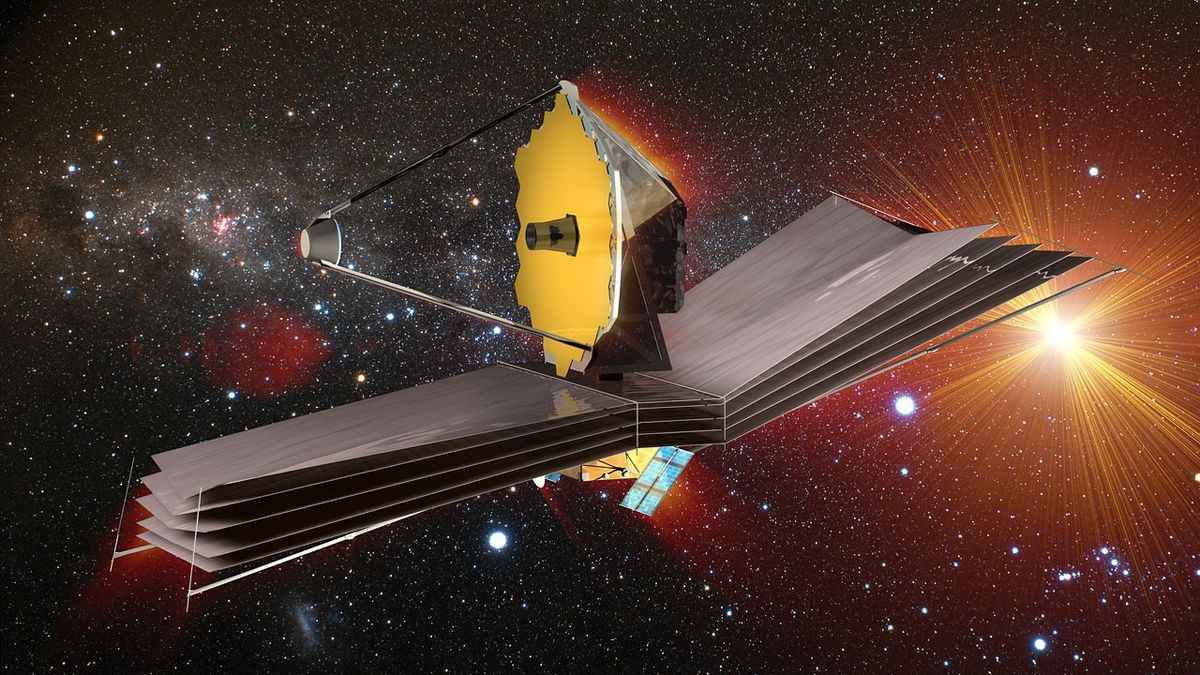El telescopio espacial James Webb mira hacia el universo primitivo y ve galaxias como la Vía Láctea

Esta simulación muestra cómo se forman las barras estelares (izquierda) y cómo fluye el gas impulsado por las barras (derecha). Las barras estelares desempeñan un papel importante en la evolución de las galaxias al canalizar el gas hacia las regiones centrales de una galaxia, donde se convierte rápidamente en nuevas estrellas, a un ritmo típicamente de 10 a 100 veces más rápido que el del resto de la galaxia. Las barras también ayudan indirectamente a crear agujeros negros supermasivos en los centros de las galaxias, canalizando gas en parte del camino. Crédito: Francoise Combes, Observatorio de París
nuevas imagenes de[{” attribute=””>NASA’s James Webb Space Telescope (JWST) reveal for the first time galaxies with stellar bars — elongated features of stars stretching from the centers of galaxies into their outer disks — at a time when the universe was a mere 25% of its present age. The finding of so-called barred galaxies, similar to our Milky Way, this early in the universe will require astrophysicists to refine their theories of galaxy evolution.
Prior to JWST, images from the Hubble Space Telescope had never detected bars at such young epochs. In a Hubble image, one galaxy, EGS-23205, is little more than a disk-shaped smudge, but in the corresponding JWST image taken this past summer, it’s a beautiful spiral galaxy with a clear stellar bar.
“I took one look at these data, and I said, ‘We are dropping everything else!’” said Shardha Jogee, professor of astronomy at The University of Texas at Austin. “The bars hardly visible in Hubble data just popped out in the JWST image, showing the tremendous power of JWST to see the underlying structure in galaxies,” she said, describing data from the Cosmic Evolution Early Release Science Survey (CEERS), led by UT Austin professor, Steven Finkelstein.

The power of JWST to map galaxies at high resolution and at longer infrared wavelengths than Hubble allows it look through dust and unveil the underlying structure and mass of distant galaxies. This can be seen in these two images of the galaxy EGS23205, seen as it was about 11 billion years ago. In the HST image (left, taken in the near-infrared filter), the galaxy is little more than a disk-shaped smudge obscured by dust and impacted by the glare of young stars, but in the corresponding JWST mid-infrared image (taken this past summer), it’s a beautiful spiral galaxy with a clear stellar bar. Credit: NASA/CEERS/University of Texas at Austin
The team identified another barred galaxy, EGS-24268, also from about 11 billion years ago, which makes two barred galaxies existing farther back in time than any previously discovered.
In an article accepted for publication in The Astrophysical Journal Letters, they highlight these two galaxies and show examples of four other barred galaxies from more than 8 billion years ago.
“For this study, we are looking at a new regime where no one had used this kind of data or done this kind of quantitative analysis before,” said Yuchen “Kay” Guo, a graduate student who led the analysis, “so everything is new. It’s like going into a forest that nobody has ever gone into.”
Bars play an important role in galaxy evolution by funneling gas into the central regions, boosting star formation.
“Bars solve the supply chain problem in galaxies,” Jogee said. “Just like we need to bring raw material from the harbor to inland factories that make new products, a bar powerfully transports gas into the central region where the gas is rapidly converted into new stars at a rate typically 10 to 100 times faster than in the rest of the galaxy.”
Bars also help to grow supermassive black holes in the centers of galaxies by channeling the gas part of the way.
Esta simulación muestra cómo se forman las barras estelares (izquierda) y cómo fluye el gas impulsado por las barras (derecha). Las barras estelares desempeñan un papel importante en la evolución de las galaxias al canalizar el gas hacia las regiones centrales de una galaxia, donde se convierte rápidamente en nuevas estrellas, a un ritmo típicamente de 10 a 100 veces más rápido que el del resto de la galaxia. Las barras también ayudan indirectamente a crear agujeros negros supermasivos en los centros de las galaxias, canalizando gas en parte del camino. Crédito: Francoise Combes, Observatorio de París
El descubrimiento de barras durante estas épocas tempranas sacude los escenarios de evolución de galaxias de varias maneras.
“Este descubrimiento de las primeras barras significa que los modelos de evolución galáctica ahora tienen una nueva forma de acelerar la producción de nuevas estrellas en épocas tempranas”, dijo Jogee.
Y la existencia misma de estas primeras barras desafía a los modelos teóricos, ya que tienen que acertar con la física de la galaxia para predecir la abundancia correcta de barras. El equipo probará diferentes modelos en su próximo trabajo.

Montaje de imágenes JWST que muestran seis ejemplos de galaxias barradas, dos de las cuales representan los tiempos retrospectivos más altos identificados y caracterizados cuantitativamente hasta la fecha. Las etiquetas en la esquina superior izquierda de cada figura muestran el tiempo retrospectivo de cada galaxia, que va desde hace 8,4 a 11 mil millones de años (Gyr), cuando el universo tenía solo entre el 40% y el 20% de su edad actual. Crédito: NASA/CEERS/Universidad de Texas en Austin
JWST puede revelar estructuras en galaxias distantes mejor que el Hubble por dos razones: primero, su espejo más grande ofrece mayores capacidades de captación de luz, lo que le permite ver más lejos y con mayor resolución. En segundo lugar, puede ver mejor a través del polvo porque observa en longitudes de onda infrarrojas más largas que el Hubble.
Los estudiantes graduados Eden Wise y Zilei Chen jugaron un papel clave en la investigación, revisando visualmente cientos de galaxias, buscando aquellas que parecían tener barras, lo que ayudó a reducir la lista a unas pocas docenas para que otros investigadores las analizaran con más matemáticas. aproximación.
Referencia: “Primer vistazo a las barras z > 1 en el marco de reposo en el infrarrojo cercano con JWST Early CEERS Imaging” por Yuchen Guo, Shardha Jogee, Steven L. Finkelstein, Zilei Chen, Eden Wise, Micaela B. Bagley, Guillermo Barro, Stijn Wuyts, Dale D. Kocevski, Jeyhan S. Kartaltepe, Elizabeth J. McGrath, Henry C. Ferguson, Bahram Mobasher, Mauro Giavalisco, Ray A. Lucas, Jorge A. Zavala, Jennifer M. Lotz, Norman A. Grogin, Marc Huertas-Company, Jesús Vega-Ferrero, Nimish P. Hathi, Pablo Arrabal Haro, Mark Dickinson, Anton M. Koekemoer, Casey Papovich, Nor Pirzkal, LY Aaron Yung, Bren E. Backhaus, Eric F. Bell, Antonello Calabrò, Nikko J. Cleri, Rosemary T. Coogan, MC Cooper, Luca Costantin, Darren Croton, Kelcey Davis, Alexander de la Vega, Avishai Dekel, Maximilien Franco, Jonathan P. Gardner, Benne W. Holwerda, Taylor A. Hutchison, Viraj Pandya, Pablo G. Pérez-González, Swara Ravindranath, Caitlin Rose, Jonathan R. Trump y Weichen Wang, Aceptada, Las cartas de la revista astrofísica.
arXiv:2210.08658
Otros coautores de UT Austin son Steven Finkelstein, Micaela Bagley y Maximilien Franco. Docenas de coautores de otras instituciones provienen de EE. UU., Reino Unido, Japón, España, Francia, Italia, Australia e Israel.
El financiamiento para esta investigación fue proporcionado en parte por Roland K. Blumberg Endowment in Astronomy, Heising-Simons Foundation y NASA. Este trabajo se basó en los recursos del Centro de Computación Avanzada de Texas, incluida Frontera, la supercomputadora más poderosa de una universidad estadounidense.

“Creador malvado. Estudiante. Jugador apasionado. Nerd incondicional de las redes sociales. Adicto a la música”.




